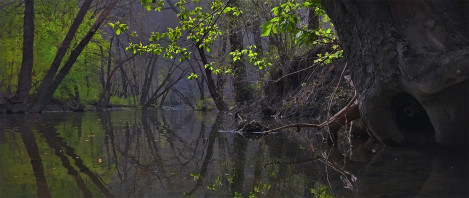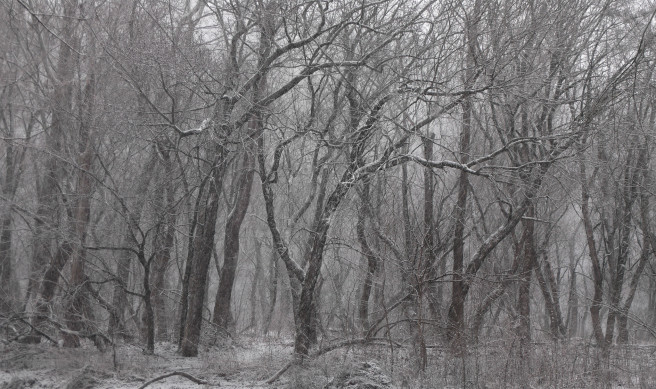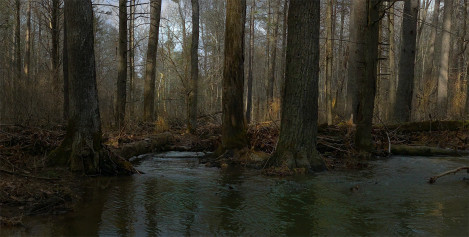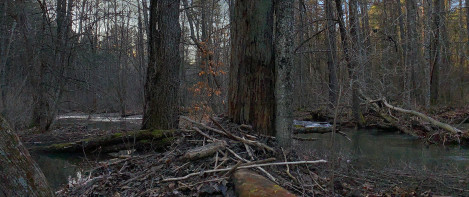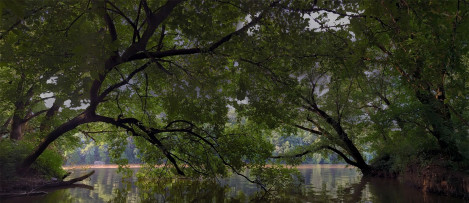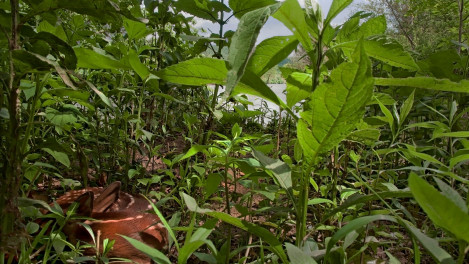A true wilderness experience
Mark Jennings
When I realized that I wanted to photograph landscape, I walked into the woods and outback. My inspiration was what I saw there. But at another level, I had countless days and experiences in similar locations near various residences, going all the way back to those of my boyhood. A farm raised grandfather, who found time to hunt, fish, and gather wild plants all his life, had introduced me to his beloved local woods and waters when I was young. His affection for such places has lived on in me.
Home is now a farming valley in the mountains of eastern West Virginia (US).
Here in the forested mountains and limestone farming valleys of eastern West Virginia(US), wooded river and stream bottoms bristle with terrain features, vegetation communities, habitats, ecological dynamics, and natural architectures that I can’t resist. From high terraces bordering uplands, to near shore islands and bars flanking main channels, they are inexhaustible subjects.
Kenneth Grahame (who wrote The Wind in the Willows) put it right. Sometimes, there’s nothing else half as worth doing as bumping my canoe along river banks - I mean right up against them. And I slip into guts and creeks and explore on foot, too.
One day, a tiny flicker of movement materialised into a mole (Scalopus aquaticus*) clambering down a recently collapsed bank like that shown in the right mid-ground of “Mole Hall”. The little creature launched, and to my amazement, with stubby legs churning it slalomed through fallen branches and reached open water. Across the main channel’s 250 m, it laboured and then climbed up the bank. It disappeared in floodplain litter.
Over the following days, the feat kept coming back to me. I was charmed by the little and humble places in nature that Grahame sang, and I was reminded that a lot of eyes actually do gaze at the world from down low. But I grumbled to myself about the pressures caused by climate change.
Among other things, I reconsidered my taste in river banks.
*The species name “aquaticus” derives from the animals’ slightly webbed digits but not from any exceptional aquatic habits.
Eddie is a woodsman. He’s also a professional wood craftsman, and among the items he makes for himself are hunting bows. Every year, he goes out after white-tailed deer (Odocoileus virginianus) for the table.
On a snowy morning, Eddie ambushed a deer in a big creek bottom near home. Deer sometimes wait out a heavy storm in the protection of low-lying bottoms like the one shown in “Snow in the Woods on Flynn Creek.”
Just as Eddie released the arrow, however, the still unsuspecting animal moved a little and consequently suffered a serious but not quickly incapacitating wound. Eddie knew that he might be in for a long and possibly unsuccessful chase if he tried to close right away and the deer saw or smelled him for the first time. He also knew that if he remained hidden and waited 20 minutes, the deer probably would soon tire, bed, and then get stiff and slow. He waited.
Eddie often stopped to look around through the falling, swirling snow.
To his surprise, during a scan in patchy undergrowth, Eddie saw just yards off and facing away, a big old grey muzzled black bear(Ursus americanus), a boar, or male. It was sitting, nose up in the air, searching the rising wind.
Eddie stood and watched for a minute. Then, on impulse, he noiselessly crept up behind the preoccupied bear and tapped it on the shoulder with the tip of his bow.
He said the animal turned casually, did a double take, spun, and was gone. Soon after, Eddie located the deer and puts it down.
The north-south running headwater fork of a big creek near home is steep and fast over its last mile. There, it plunges through a narrow ravine stuffed with dense evergreen rhododendron (Rhododendron sp.) thickets. But by pushing through, one eventually makes out bright gaps ahead. Then, the bottom levels widen, and the woods open up here and there, as shown in “Flood Debris Jam on the North Fork.”
The next mile, which is still as far up the fork as I’ve been, is a complexly structured, mostly wooded wetland. The fork meanders across the floor. Beavers (Castor canadensis) have built dams, ponds, and dwellings, as shown in the image “Bank Lodge.” There is also some meadow.
Although the forest here is generally more open than that lower down, the going is still circuitous, in good part because of a large number of fallen ash(Fraxinus sp.) and hemlocks(Tsuga canadensis). The invasive woolly adelgid (Agrilus planipennis) killed the hemlocks, and the invasive emerald ash borer (Adelges tsugae) killed the ash. Decades have passed, and the snags have come down, adding another dimension to a bottom floor already supporting life forms and microhabitats enough to entertain any naturalist.
Many watercourse bottoms, often densely forested, dark, wet, and little travelled, have been the setting of Western folklore. It doesn’t take being a romantic, however, to look down into one and wonder what goes on in these places.
One late fall morning dozens of fox tracks got me searching after discovering them on a small sandy patch of abandoned woods road. The den turned up 50 meters away, set at the edge of a swampy stream bottom. It was dug into a low earthen mound likely raised decades before by the root disc of a long since rotted away wind throw. A thicket surrounded everything.
Three afternoons later I made myself comfortable in the fork of a leaning tree overlooking the site. A sharp two note bark announced a red fox(Vulpes vulpes) pair’s separate entrances from the swamp at the start of the evening. Then, for an hour, they played, poked around, and lounged in the den area. But abruptly and without ceremony, they followed their respective steps back into the dusk filled swamp. The male stopped to look directly up at me for long moments as it passed below.
Outdoor activity in my rural state traditionally and typically tends toward the communal. ”We” go fishing. “We” go hunting. “We” go pick ramps**. “We” go pick cranberries***. “We” rake and bale the hay. The cooperative approach can offer social opportunity as well as enhanced productivity or recreational enjoyment. Among individuals and communities that have remained at least to some degree close to the land, I’ve never detected much idealisation of the individual’s experience in nature as more authentic or more deeply felt.
To be sure, some people do spend a lot of time alone in the woods, but nothing much is thought of it. It just goes with the task at hand. The admiration earned by people here who do spend a lot of time alone in the wild - trappers and gatherers of marketable medicinal plants notably – is a reward for their skills and success and not for personal development through solitary experience in wild nature.
The communality appears to contrast with the importance attached to the individual experience in nature that is common in the swath of society that reads and subscribes to Thoreau.
During Thoreau’s third and last trip to the still being logged Maine woods, in 1857, he refused to halt the party at the occasional isolated cabins along the route. This despite his guide’s explanations that such visits were an always observed courtesy to people welcoming news about the outside world, and what’s more, were a vital exchange of information about conditions ahead and behind.
But for Thoreau, part of the contemporary intelligentsia, a true wilderness experience in good part was the absence of people, or at least the absence of people who were not Native Americans living strictly by tradition, a type he did not encounter. In a way his definition of wilderness considered what it was not, rather than what it was.
Now and then I duck into the creek shown in the photograph “Creek Mouth”. It’s located on one of the area’s bigger rivers. I tie up to an over hanging branch, slip down into the bottom of the canoe, lean back against the seat, and I have lunch.
My creek figured in the actual border conflict. During the early and mid 1700s, Native American military units from the more westerly Ohio River watershed often routed down this creek’s hollow on their way to raiding English colonial settlements to the east.
Today, the spot lies within a big tract managed by the National Park Service. It is popular with anglers from across the region.
I sit in the bottom of the canoe and lounge back against the seat. I enjoy my lunch. Fishing boats drift by now and then, their anglers casting, casting, casting. From the left and a little downstream occasionally come the happy conversation and the laughter of small parties fishing from the bank at a popular spot. There the outflow from the creek and the currents in the river’s main channel combine to form a range of depths, temperatures, and bottom features that attract a variety of riverine life.
For a time at least, all seems right with the world.
Just landed on a near shore island at the top of a braided reach, I noticed a white-tailed deer fawn at my feet in the wing-stem(Verbesina alternifolia). Crouching, I worked fast to frame “Oops!” and then backed off. Readers might know that for the first week or so of life fawns generally will not budge no matter how close the danger. Their best defense is going undetected. I have seen older doe chase dogs and coyotes(Canis latrans) ranging too close to hidden fawns. Not far off and always watching, mother attends the very young fawns sparingly and by that often avoids alerting predators.
References
** Ramps(Allium tricoccum) are a wild woodland onion traditionally collected in the spring and featured at community social dinners.
*** Cranberries(Vaccinium sp.) are found in high elevation bogs and traditionally attracted gatherings in the fall for picking and socialising.
- Mole Hall
- Snow In The Woods On Flynn Creek
- Flood Debris Jam on the North Fork
- Creek Mouth
- Bank Lodge
- Oops!


